- Accueil
- Pages cachées
- 17/01/2024 NEWS
17/01/2024 NEWS
INSTITUT SUPERIEUR D'ANTHROPOLOGIE
INSTITUTE OF ANTHROPOLOGY
ONLINE COURSES / COURS A DISTANCE
INSCRIPTIONS OUVERTES
REGISTER NOW
BULGARIE – 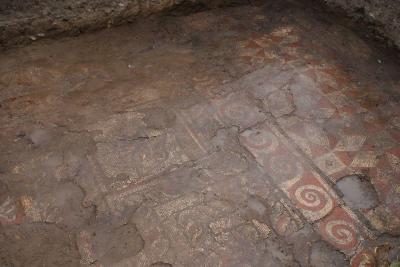
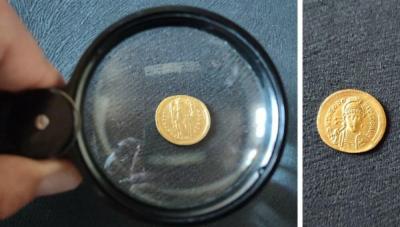 Marcianopolis - Archaeologists discovered floor mosaics with early Christian designs and nearly 800 artifacts in the archaeological reserve of Marcianopolis in Devnya, in the northeastern part of Bulgaria. Floor mosaics with early Christian designs were found in the remains of a building. Archaeologists are not yet sure whether it was a public building or it belonged to a rich Roman citizen. The tentative dating of the mosaics is in the first half of the 4th century AD. The finds from the current archaeological season in Devnya contain another thousand bronze coins, several clay lamps and two clay vessels, which are awaiting scientific processing and restoration. The vessels had a ritual use and were related to the personality of the person buried, Mosaic Museum director Ivan Sutev said in a statement to BTA. They are richly decorated and the workmanship is exquisite, he added. The find includes a vessel for pouring liquids as offering to a deity, and a wine jug with a trefoil mouth (oenochoe). A simple kitchen pan was also found along with these. All this leads archaeologists to suggest that a Roman citizen of Marcianopolis may have been laid to rest in the tomb, but that he may have had more specific functions: a soldier, a cook, or even a priest, Sutev said. Pottery that was discovered in the basilica’s environs during excavations in 2023 has since been restored. Among these are a mortarium vessel for liquids and an exquisite crater-shaped pot for liquids. These were located in the structure with the mosaic floors. Coins from the time of Emperor Theodosius II were also found scattered on the floor. In 447, Attila’s Huns captured and destroyed Marcionopolis after conquering the entire Balkan Peninsula but failing to capture Constantinople. That is determined by 20 gold coins scattered on the floor of the building being studied. On one side of the coins is an image of Theodosius II, while on the other is the patron goddess of Constantinople. Among the coins discovered during the Marcianopolis excavations were those from the city’s founding in the second century. The latter are dated to the sixth century, around the time of Emperor Justinian.
Marcianopolis - Archaeologists discovered floor mosaics with early Christian designs and nearly 800 artifacts in the archaeological reserve of Marcianopolis in Devnya, in the northeastern part of Bulgaria. Floor mosaics with early Christian designs were found in the remains of a building. Archaeologists are not yet sure whether it was a public building or it belonged to a rich Roman citizen. The tentative dating of the mosaics is in the first half of the 4th century AD. The finds from the current archaeological season in Devnya contain another thousand bronze coins, several clay lamps and two clay vessels, which are awaiting scientific processing and restoration. The vessels had a ritual use and were related to the personality of the person buried, Mosaic Museum director Ivan Sutev said in a statement to BTA. They are richly decorated and the workmanship is exquisite, he added. The find includes a vessel for pouring liquids as offering to a deity, and a wine jug with a trefoil mouth (oenochoe). A simple kitchen pan was also found along with these. All this leads archaeologists to suggest that a Roman citizen of Marcianopolis may have been laid to rest in the tomb, but that he may have had more specific functions: a soldier, a cook, or even a priest, Sutev said. Pottery that was discovered in the basilica’s environs during excavations in 2023 has since been restored. Among these are a mortarium vessel for liquids and an exquisite crater-shaped pot for liquids. These were located in the structure with the mosaic floors. Coins from the time of Emperor Theodosius II were also found scattered on the floor. In 447, Attila’s Huns captured and destroyed Marcionopolis after conquering the entire Balkan Peninsula but failing to capture Constantinople. That is determined by 20 gold coins scattered on the floor of the building being studied. On one side of the coins is an image of Theodosius II, while on the other is the patron goddess of Constantinople. Among the coins discovered during the Marcianopolis excavations were those from the city’s founding in the second century. The latter are dated to the sixth century, around the time of Emperor Justinian.
AUSTRALIE –  - Sonar mapping revealed signs of rivers and freshwater lakes across a now-sunken landscape almost twice the size of the UK, where humans could once have thrived. About 70,000 years ago, a vast swathe of land that's now submerged off the coast of Australia could once have supported a population of half a million people. The undersea territory was so large it could have functioned as a stepping stone for migration from modern-day Indonesia to Australia, finds a new study published Dec. 15 in the journal Quaternary Science Reviews. "We're talking about a landscape that's quite submerged, over 100 meters [330 feet] below sea level today," Kasih Norman, an archeologist at Griffith University in Queensland, Australia, and lead author on the new study, told Live Science. This Australian "Atlantis" comprised a large stretch of continental shelf that, when above sea level, would have connected the regions of Kimberley and Arnhem Land, which today are separated by a large ocean bay. This ancient expanded Australian landmass once formed part of a palaeocontinent that connected modern-day Australia, New Guinea, and Tasmania into a single unit known as Sahul.
- Sonar mapping revealed signs of rivers and freshwater lakes across a now-sunken landscape almost twice the size of the UK, where humans could once have thrived. About 70,000 years ago, a vast swathe of land that's now submerged off the coast of Australia could once have supported a population of half a million people. The undersea territory was so large it could have functioned as a stepping stone for migration from modern-day Indonesia to Australia, finds a new study published Dec. 15 in the journal Quaternary Science Reviews. "We're talking about a landscape that's quite submerged, over 100 meters [330 feet] below sea level today," Kasih Norman, an archeologist at Griffith University in Queensland, Australia, and lead author on the new study, told Live Science. This Australian "Atlantis" comprised a large stretch of continental shelf that, when above sea level, would have connected the regions of Kimberley and Arnhem Land, which today are separated by a large ocean bay. This ancient expanded Australian landmass once formed part of a palaeocontinent that connected modern-day Australia, New Guinea, and Tasmania into a single unit known as Sahul.
POLOGNE – 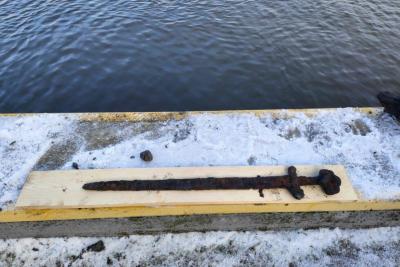 Włocławek - A sword believed to be over 1,000 years old has been found at the bottom of a river in Poland. The discovery has sparked speculation that the item may have belonged to the Vikings. However, an expert has expressed scepticism. The sword was discovered in Włocławek, a city of 100,000 in central Poland, during dredging works on a marina in the Vistula river. The find was announced last week by the municipal sport and leisure centre, which shared pictures of the item. The centre said that it had consulted with Olaf Popkiewicz, an archaeologist and weapons expert, who gave an initial estimate that the sword could date back to the 9th century – a time before the Polish state was founded. The expert explained that these types of swords were formerly often referred to as “Viking swords”, but are now classified among the so-called Carolingian swords created around the Rhine on territories that are now part of Germany. Rhineland swords were widely traded and may have reached Central Europe, including Poland, in part via Scandinavia. The fact that a sword is decorated with Scandinavian patterns does not necessarily mean that it was a Viking sword. “Scandinavian craftsmen only framed them according to their own fashions and needs,” explains Grochowski. More than 90 swords dating from the second half of the ninth to the twelfth century have been found Poland, with the majority dating from 950-1100.
Włocławek - A sword believed to be over 1,000 years old has been found at the bottom of a river in Poland. The discovery has sparked speculation that the item may have belonged to the Vikings. However, an expert has expressed scepticism. The sword was discovered in Włocławek, a city of 100,000 in central Poland, during dredging works on a marina in the Vistula river. The find was announced last week by the municipal sport and leisure centre, which shared pictures of the item. The centre said that it had consulted with Olaf Popkiewicz, an archaeologist and weapons expert, who gave an initial estimate that the sword could date back to the 9th century – a time before the Polish state was founded. The expert explained that these types of swords were formerly often referred to as “Viking swords”, but are now classified among the so-called Carolingian swords created around the Rhine on territories that are now part of Germany. Rhineland swords were widely traded and may have reached Central Europe, including Poland, in part via Scandinavia. The fact that a sword is decorated with Scandinavian patterns does not necessarily mean that it was a Viking sword. “Scandinavian craftsmen only framed them according to their own fashions and needs,” explains Grochowski. More than 90 swords dating from the second half of the ninth to the twelfth century have been found Poland, with the majority dating from 950-1100.
https://notesfrompoland.com/2024/01/16/thousand-year-old-sword-found-in-polish-river/
ISRAEL – 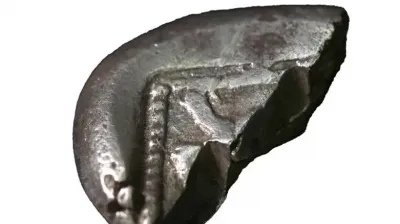 Judean Hills - Rare evidence for the earliest use of coins in the country — an extremely rare silver coin dated to the Persian period (6th–5th centuries BCE) — was recently discovered in an Israel Antiquities Authority excavation at a site in the Judean Hills. The excavation, carried out during the course of infrastructure works undertaken by the Netivei Israel National Transport Infrastructure Company, also exposed a building from the First Temple Period, with even earlier evidence for commerce in the form of a sheqel weight. According to Michal Mermelstein and Danny Benayoun, excavation directors on behalf of the Israel Antiquities Authority, “The site was situated in the rural area of the Kingdom of Judah, whose capital was in Jerusalem. It was first settled in the First Temple period, in the 7th century BCE (2,700 years ago), during the reigns of the kings of Judah, Hezekiah, Manasseh, Amon and Josiah, a peak settlement period in the kingdom of Judah. A characteristic ‘four-room house’ was uncovered from this period, and the sheqel weight, found on the floor of one of the rooms in the house, provides early evidence for trade. The dome-shaped stone weight would have been used for weighing metals, spices, and other expensive commodities. The sign on the weight was an ancient Egyptian (hieratic) abbreviation for the word sheqel, and the single incised stroke represents one sheqel. The weight weighs 11.07 g.”
Judean Hills - Rare evidence for the earliest use of coins in the country — an extremely rare silver coin dated to the Persian period (6th–5th centuries BCE) — was recently discovered in an Israel Antiquities Authority excavation at a site in the Judean Hills. The excavation, carried out during the course of infrastructure works undertaken by the Netivei Israel National Transport Infrastructure Company, also exposed a building from the First Temple Period, with even earlier evidence for commerce in the form of a sheqel weight. According to Michal Mermelstein and Danny Benayoun, excavation directors on behalf of the Israel Antiquities Authority, “The site was situated in the rural area of the Kingdom of Judah, whose capital was in Jerusalem. It was first settled in the First Temple period, in the 7th century BCE (2,700 years ago), during the reigns of the kings of Judah, Hezekiah, Manasseh, Amon and Josiah, a peak settlement period in the kingdom of Judah. A characteristic ‘four-room house’ was uncovered from this period, and the sheqel weight, found on the floor of one of the rooms in the house, provides early evidence for trade. The dome-shaped stone weight would have been used for weighing metals, spices, and other expensive commodities. The sign on the weight was an ancient Egyptian (hieratic) abbreviation for the word sheqel, and the single incised stroke represents one sheqel. The weight weighs 11.07 g.”
https://www.israelnationalnews.com/news/383727
INDE – 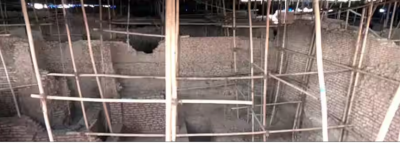 Gujarat's Vadnagar - An excavation in Gujarat's Vadnagar unveiled evidence of cultural continuity in the Indian subcontinent since 800 BCE. Vadnagar is the hometown of Indian Prime Minister Modi. The findings thus imply that the "Dark Age" was a myth and that cultures continuously existed in the region without total annihilation during the last 5,500 years. The study also indicates that the rise and fall of different kingdoms during the 3,000-year period and recurrent invasions of India by central Asian warriors were driven by severe change in climate like rainfall or droughts. The findings [have been] just published in a paper titled 'Climate, human settlement, and migration in South Asia from early historic to medieval period: evidence from new archaeological excavation at Vadnagar, Western India' in the prestigious Elsevier journal Quaternary Science Reviews
Gujarat's Vadnagar - An excavation in Gujarat's Vadnagar unveiled evidence of cultural continuity in the Indian subcontinent since 800 BCE. Vadnagar is the hometown of Indian Prime Minister Modi. The findings thus imply that the "Dark Age" was a myth and that cultures continuously existed in the region without total annihilation during the last 5,500 years. The study also indicates that the rise and fall of different kingdoms during the 3,000-year period and recurrent invasions of India by central Asian warriors were driven by severe change in climate like rainfall or droughts. The findings [have been] just published in a paper titled 'Climate, human settlement, and migration in South Asia from early historic to medieval period: evidence from new archaeological excavation at Vadnagar, Western India' in the prestigious Elsevier journal Quaternary Science Reviews
EQUATEUR – 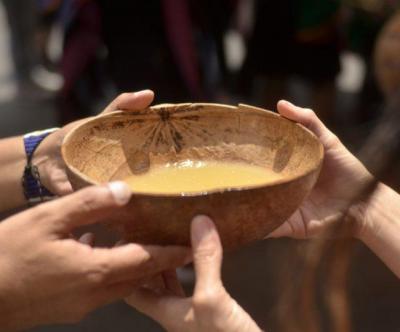 Upano Valley -- Archaeologists have discovered 2,500 year old beer jugs in an extensive ancient city in the Amazon rainforest, which has been lying completely hidden for thousands of years. Located in eastern Ecuador, the city was placed near to a volcano, where the rich soils provided perfect growing conditions for crops, but also might have been the destructive power that caused the society’s demise. The beer, which has a full name of Chicha de jora, is a corn beer which is prepared by germinating maize, extracting the malt sugars and boiling the wort, like a traditional barley beer, and then fermenting it in large vessels. These were traditionally large pieces of eathenware, and would be fermented for several days before consumption. The research, published in the journal Science as Two thousand years of garden urbanism in the Upper Amazon, discovered that a “dense system of pre-Hispanic urban centres has been found” in the Upano Valley of Amazonian Ecuador within the foothills of the Andes.
Upano Valley -- Archaeologists have discovered 2,500 year old beer jugs in an extensive ancient city in the Amazon rainforest, which has been lying completely hidden for thousands of years. Located in eastern Ecuador, the city was placed near to a volcano, where the rich soils provided perfect growing conditions for crops, but also might have been the destructive power that caused the society’s demise. The beer, which has a full name of Chicha de jora, is a corn beer which is prepared by germinating maize, extracting the malt sugars and boiling the wort, like a traditional barley beer, and then fermenting it in large vessels. These were traditionally large pieces of eathenware, and would be fermented for several days before consumption. The research, published in the journal Science as Two thousand years of garden urbanism in the Upper Amazon, discovered that a “dense system of pre-Hispanic urban centres has been found” in the Upano Valley of Amazonian Ecuador within the foothills of the Andes.
https://www.thedrinksbusiness.com/2024/01/archaeologists-discover-2500-year-old-beer-jugs/
FRANCE – 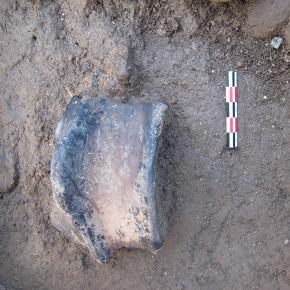 Beg ar Loued - Le site de Beg ar Loued sur l’île de Molène (Finistère, France) permet, pour la première fois sur la façade atlantique européenne, de documenter les pratiques culinaires de la fin du Néolithique et du début de l’âge du Bronze grâce à la bonne conservation des lipides piégés dans les parois poreuses des céramiques. À l’aide de la combinaison d’approches moléculaires et isotopiques, ces travaux dévoilent les choix effectués dans la préparation et la consommation des aliments. Il en ressort que les ressources terrestres sont préparées dans les céramiques alors que les produits de la mer sont traités différemment. L’article est publié dans les Comptes Rendus Palevol. Les résultats obtenus montrent l’excellente préservation des lipides dans les céramiques, ce qui a permis d’identifier la nature des denrées préparées et consommées. Ces dernières sont caractérisées par une écrasante majorité de produits animaux terrestres issus de l’élevage, principalement des produits laitiers de petits ruminants dont la viande était également consommée. Étonnamment, les céramiques n’étaient pas ou très peu utilisées pour la préparation ou la consommation de produits de la mer dont on sait, par les vestiges fauniques (restes de poissons et de coquillages), qu’ils étaient aussi largement exploités. Ces résultats mettent donc en lumière des pratiques culinaires spécifiques avec des poteries dont l’usage est dédié principalement à certaines denrées. En outre, des graisses animales et des cires ont été identifiées dans les couches superficielles de certains récipients, démontrant l’application de techniques spécifiques de finition incorporant plusieurs types de substances grasses. Ces recherches sont maintenant amenées à s’étendre à d’autres sites insulaires et continentaux de la façade atlantique afin de mieux cerner les habitudes alimentaires, les pratiques culinaires et les choix culturels mis en jeu par les populations néolithiques et de l’âge du Bronze ainsi que leur évolution au cours du temps.
Beg ar Loued - Le site de Beg ar Loued sur l’île de Molène (Finistère, France) permet, pour la première fois sur la façade atlantique européenne, de documenter les pratiques culinaires de la fin du Néolithique et du début de l’âge du Bronze grâce à la bonne conservation des lipides piégés dans les parois poreuses des céramiques. À l’aide de la combinaison d’approches moléculaires et isotopiques, ces travaux dévoilent les choix effectués dans la préparation et la consommation des aliments. Il en ressort que les ressources terrestres sont préparées dans les céramiques alors que les produits de la mer sont traités différemment. L’article est publié dans les Comptes Rendus Palevol. Les résultats obtenus montrent l’excellente préservation des lipides dans les céramiques, ce qui a permis d’identifier la nature des denrées préparées et consommées. Ces dernières sont caractérisées par une écrasante majorité de produits animaux terrestres issus de l’élevage, principalement des produits laitiers de petits ruminants dont la viande était également consommée. Étonnamment, les céramiques n’étaient pas ou très peu utilisées pour la préparation ou la consommation de produits de la mer dont on sait, par les vestiges fauniques (restes de poissons et de coquillages), qu’ils étaient aussi largement exploités. Ces résultats mettent donc en lumière des pratiques culinaires spécifiques avec des poteries dont l’usage est dédié principalement à certaines denrées. En outre, des graisses animales et des cires ont été identifiées dans les couches superficielles de certains récipients, démontrant l’application de techniques spécifiques de finition incorporant plusieurs types de substances grasses. Ces recherches sont maintenant amenées à s’étendre à d’autres sites insulaires et continentaux de la façade atlantique afin de mieux cerner les habitudes alimentaires, les pratiques culinaires et les choix culturels mis en jeu par les populations néolithiques et de l’âge du Bronze ainsi que leur évolution au cours du temps.
ITALIE – Villaggio dei Faraglioni - Des chercheurs ont découvert un système de fortification caché enfoui sous un village de l'âge du bronze en Italie. Connue sous le nom de Villaggio dei Faraglioni, la colonie est située sur Ustica, une petite île au nord de la Sicile. Elle a un « plan urbain ordonné » composé de cabanes et de routes étroites construites à la limite nord de l'île, selon un rapport. déclaration traduite de l'Institut national italien de géophysique et de volcanologie (INGV). À l'aide d'instruments tels que le géoradar et la tomographie électrique (imagerie sous la surface), une équipe d'archéologues et de géologues a découvert les restes du mur enterré, selon une étude publiée dans le numéro de janvier du Journal de géophysique appliquée. Le système de fortification en pierre en forme d'arc, que les chercheurs ont décrit comme un « puissant mur », mesure 820 pieds (250 mètres) de long et 13 à 16 pieds (4 à 5 m) de haut, selon le communiqué. Bien que le site du village ait été fouillé à de nombreuses reprises depuis les années 1970, c'est la première fois que les chercheurs découvrent les fortifications cachées. Une partie du mur de pierre servait à protéger le village.“Grâce à [the instruments]il a été possible de localiser avec précision et de manière totalement non invasive les fondations profondes du [structure] aussi longtemps que le mur, qui remplissait les fonctions de première barrière défensive,” Vincenzo Sapiagéophysicien appliqué à l'INGV, a déclaré dans le communiqué.Le village fortifié est resté actif entre 1400 et 1200 avant JC, et les chercheurs le considèrent comme « l'un des établissements méditerranéens les mieux conservés de son époque », selon le communiqué. “Notre découverte ouvre une nouvelle fenêtre sur la compréhension de cet ancien village, suggérant une complexité défensive qui dépasse les attentes”, Franco Foresta Martin, directeur du Laboratoire du Musée des Sciences de la Terre d'Ustica, associé à l'INGV, a déclaré dans le communiqué. “La technologie géophysique nous permet… de révéler des couches cachées de l'histoire, ouvrant la voie à des investigations plus approfondies sans recourir à des fouilles invasives.”
SUISSE –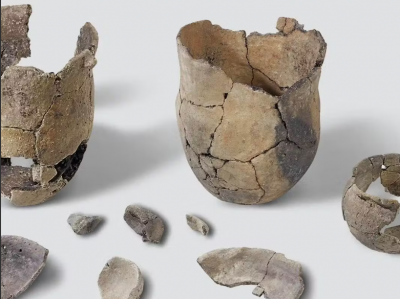
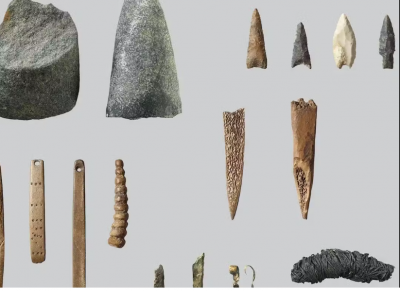 Sutz-Lattrigen - Les communautés néolithiques du lac de Bienne cultivaient de vastes réseaux de contacts jusqu'en Hongrie, selon un constat publié en deux volumes par le Service archéologique bernois. Les fouilles ont porté sur des habitats palafittiques vieux de 6000 ans, dans la baie de Sutz-Lattrigen, sur la rive sud. Les fouilles subaquatiques ont été suivies d’analyses scientifiques. Sur le site le plus ancien, l’étude des cernes de bois montre que quatre villages s’y sont succédé de 3830 à 3560 av. J.-C. «Datés souvent à l’année près grâce à la dendrochronologie, les milliers d’éléments de bois de construction mis au jour sur le site ont permis de reconstituer en détail à quelles périodes ces établissements ont été construits et occupés, quelle forme ils revêtaient et comment ils ont évolué», s'enthousiasment les archéologues bernois. Il est apparu que les populations du Néolithique étaient très mobiles et entretenaient des réseaux de contacts étendus dans toutes les directions: «Des personnes venues de l’Est de la France et d’Alsace ont fabriqué leurs récipients au bord du lac de Bienne», détaille le service archéologique bernois. Des outils en silex provenaient du sud de la France, du Bassin parisien, de Pologne, du Danemark et de Hongrie. Des haches étaient fabriquées avec des pierres des Vosges et des Alpes italiennes.
Sutz-Lattrigen - Les communautés néolithiques du lac de Bienne cultivaient de vastes réseaux de contacts jusqu'en Hongrie, selon un constat publié en deux volumes par le Service archéologique bernois. Les fouilles ont porté sur des habitats palafittiques vieux de 6000 ans, dans la baie de Sutz-Lattrigen, sur la rive sud. Les fouilles subaquatiques ont été suivies d’analyses scientifiques. Sur le site le plus ancien, l’étude des cernes de bois montre que quatre villages s’y sont succédé de 3830 à 3560 av. J.-C. «Datés souvent à l’année près grâce à la dendrochronologie, les milliers d’éléments de bois de construction mis au jour sur le site ont permis de reconstituer en détail à quelles périodes ces établissements ont été construits et occupés, quelle forme ils revêtaient et comment ils ont évolué», s'enthousiasment les archéologues bernois. Il est apparu que les populations du Néolithique étaient très mobiles et entretenaient des réseaux de contacts étendus dans toutes les directions: «Des personnes venues de l’Est de la France et d’Alsace ont fabriqué leurs récipients au bord du lac de Bienne», détaille le service archéologique bernois. Des outils en silex provenaient du sud de la France, du Bassin parisien, de Pologne, du Danemark et de Hongrie. Des haches étaient fabriquées avec des pierres des Vosges et des Alpes italiennes.
SUISSE - 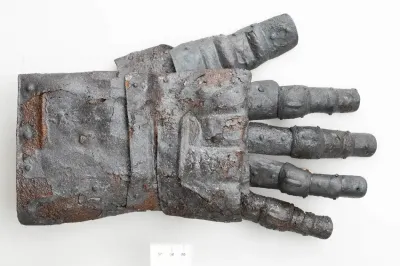 Kyburg - A press conference by the Canton of Zurich has announced the discovery of an intact medieval gauntlet dated to the 14th century. The object was found during excavations to the southeast of Kyburg Castle, located in Kyburg in the district of Pfäffikon, Switzerland. The settlement of Kyburg grew up around Kyburg Castle, which during the medieval period was known as Chuigeburch (meaning “cows-fort”). The castle today stands as one of the most expansive medieval castle complexes in Switzerland, comprising a bergfried and palas, complemented by residential and economic structures and a chapel.Excavations adjacent to the castle have found a medieval weaving cellar which was destroyed by fire during the 14th century, and traces of forging which is evidenced by the discovery of a mold and over 50 metal objects associated with smithing. Archaeologists also found a hammer, tweezers, pliers, keys, knives, bullet points, and a completely preserved 14th century gauntlet, in addition to fragments of its counterpart worn on the other hand.The intact gauntlet is a four-fold finger glove worn on the right hand, which has individual iron plates stacked like scales and linked together through side rivets. The individual glove components were fixed to the interior using supplementary rivets on a leather or textile base, which in turn was stitched onto the fabric. According to the press announcement: “The previously known gauntlets from museums and collections mostly date back to the 15th century at the earliest. Older examples from the 14th century, however, are extremely rare. So far, only five other gauntlets from this period have been found during archaeological excavations in Switzerland, although none of these pieces is anywhere near as well preserved and shows as many details of design and decoration as the Kyburg gauntlet.”
Kyburg - A press conference by the Canton of Zurich has announced the discovery of an intact medieval gauntlet dated to the 14th century. The object was found during excavations to the southeast of Kyburg Castle, located in Kyburg in the district of Pfäffikon, Switzerland. The settlement of Kyburg grew up around Kyburg Castle, which during the medieval period was known as Chuigeburch (meaning “cows-fort”). The castle today stands as one of the most expansive medieval castle complexes in Switzerland, comprising a bergfried and palas, complemented by residential and economic structures and a chapel.Excavations adjacent to the castle have found a medieval weaving cellar which was destroyed by fire during the 14th century, and traces of forging which is evidenced by the discovery of a mold and over 50 metal objects associated with smithing. Archaeologists also found a hammer, tweezers, pliers, keys, knives, bullet points, and a completely preserved 14th century gauntlet, in addition to fragments of its counterpart worn on the other hand.The intact gauntlet is a four-fold finger glove worn on the right hand, which has individual iron plates stacked like scales and linked together through side rivets. The individual glove components were fixed to the interior using supplementary rivets on a leather or textile base, which in turn was stitched onto the fabric. According to the press announcement: “The previously known gauntlets from museums and collections mostly date back to the 15th century at the earliest. Older examples from the 14th century, however, are extremely rare. So far, only five other gauntlets from this period have been found during archaeological excavations in Switzerland, although none of these pieces is anywhere near as well preserved and shows as many details of design and decoration as the Kyburg gauntlet.”
https://www.heritagedaily.com/2024/01/archaeologists-find-intact-medieval-gauntlet/150272
ISRAEL – 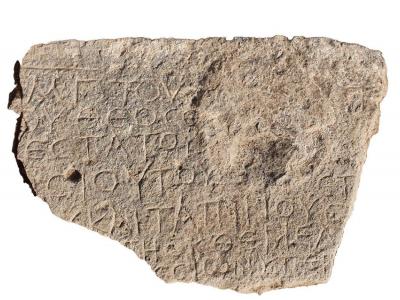 et-Taiyiba - Archaeologists excavating in the village of et-Taiyiba, located in the Valley of Megiddo (also known as the Jezreel Valley), have uncovered an inscription bearing the name “Christ, born of Mary”. According to Christian eschatology, the valley is considered the location for the ultimate battle between the forces of good and evil, commonly referred to as Armageddon. The term “Armageddon” is derived from the Hebrew “Har Megiddo,” meaning ‘Mount Megiddo.’The stone inscription is engraved in Greek and was found in a doorway entrance to a building that dates to the late 5th century AD, which was later incorporated into a later structure from the Byzantine or Early Islamic period. Excavations of the structure have also identified two rooms containing mosaic flooring decorated with geometric designs. Dr Leah Di-Segni, a researcher at the Institute of Archaeology of the Hebrew University of Jerusalem, said that the inscription is a dedicatory to Jesus, the Son of Mary, which states: “Christ born of Mary. This work of the most God-fearing and pious bishop [Theodo]sius and the miserable Th[omas] was built from the foundation . Whoever enters should pray for them.” Theodosius, whom the text refers to as the building’s founder, was one of the first Christian bishops in the region and had religious authority of the city of Bet She’an which served as the capital of the Byzantine province of Palaestina Secunda. According to the researchers, the inscription is intended to provide protection from the evil eye and has been found at other sites from across the Byzantine world. Dr Walid Atrash of the Israel Antiquities Authority (IAA) said, “This is the first evidence of the Byzantine church’s existence in the village of et-Taiyiba, and it adds to other finds attesting to the activities of Christians who lived in the region.
et-Taiyiba - Archaeologists excavating in the village of et-Taiyiba, located in the Valley of Megiddo (also known as the Jezreel Valley), have uncovered an inscription bearing the name “Christ, born of Mary”. According to Christian eschatology, the valley is considered the location for the ultimate battle between the forces of good and evil, commonly referred to as Armageddon. The term “Armageddon” is derived from the Hebrew “Har Megiddo,” meaning ‘Mount Megiddo.’The stone inscription is engraved in Greek and was found in a doorway entrance to a building that dates to the late 5th century AD, which was later incorporated into a later structure from the Byzantine or Early Islamic period. Excavations of the structure have also identified two rooms containing mosaic flooring decorated with geometric designs. Dr Leah Di-Segni, a researcher at the Institute of Archaeology of the Hebrew University of Jerusalem, said that the inscription is a dedicatory to Jesus, the Son of Mary, which states: “Christ born of Mary. This work of the most God-fearing and pious bishop [Theodo]sius and the miserable Th[omas] was built from the foundation . Whoever enters should pray for them.” Theodosius, whom the text refers to as the building’s founder, was one of the first Christian bishops in the region and had religious authority of the city of Bet She’an which served as the capital of the Byzantine province of Palaestina Secunda. According to the researchers, the inscription is intended to provide protection from the evil eye and has been found at other sites from across the Byzantine world. Dr Walid Atrash of the Israel Antiquities Authority (IAA) said, “This is the first evidence of the Byzantine church’s existence in the village of et-Taiyiba, and it adds to other finds attesting to the activities of Christians who lived in the region.